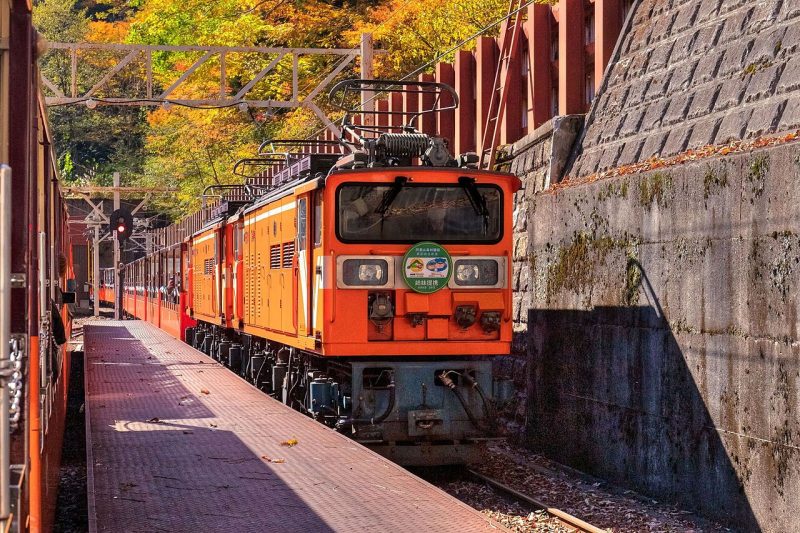The Sagano train experience in Kyoto stands at the top of millions of travelers’ bucket lists this year. More than 2.7 million Americans visited Japan in 2024 alone—a remarkable increase of 33% over 2023. This surge explains why many travelers voted Japan their number-one favorite country.
Autumn in Japan brings the most magical train travel experiences. The country’s landscape is 70% forests that burst into a spectacular canvas of red, gold, and amber from October to early December. Perfect conditions emerge with crisp days and cool nights that create these fiery hues. Japan’s autumn landscapes become truly unforgettable during scenic train rides.
The Kurobe Gorge Railway is part of the 7 best autumn train rides that showcase Japan’s most breathtaking fall colors.
1. Oigawa Railway, Shizuoka
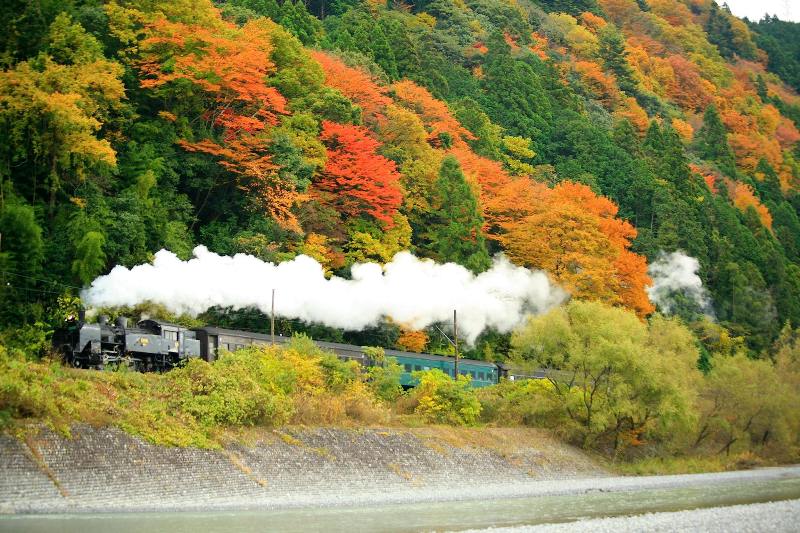
The steam locomotives of Oigawa Railway in Shizuoka Prefecture stand out as Japan’s best autumn train trip. The railway snakes through the beautiful Oi River valley, where tea plantations meet forests. Passengers can see an array of reds and golds through their windows as autumn colors paint the landscape. These perfect conditions draw photographers who want to capture Japan’s traditional countryside in its fall glory.
The trains themselves take you back in time. Wooden seats, vintage lamps, and old-style fans fill each carriage. The train’s whistle echoes through valleys, adding to the historical charm. Train buffs will love this moving museum that offers more than just pretty views.
Fall brings special tour packages to the Oigawa Railway. Visitors can enjoy two-day, three-night trips that come with local bento boxes. The tours include stops at famous leaf-viewing spots like Korankei with its 4,000 maple trees and Oguni Shrine. The packages end with a soothing dip in Yutaka Onsen hot springs. These complete packages let visitors soak in the region’s autumn culture.
The railway hit some rough patches. A typhoon damaged parts of the line in autumn 2022, forcing closures for repairs. The railway started running again on October 1, 2024, on a section of the Oigawa Main Line. While the full 40-kilometer stretch from Kanaya Station to Senzu Station isn’t ready yet, trains now run between Ieyama Station and Kawaneonsen-Sasamado Station – about three kilometers.
The main route runs from Shin-Kanaya Station to Ieyama Station for those planning their trip. Late November to early December offers the best views of autumn leaves along this route. Book ahead if you want to ride one of Japan’s most photographed and beloved autumn train trips – it’s been quite popular since its recent partial reopening.
2. Sagano Romantic Train, Kyoto

The Sagano Romantic Train ranks among Kyoto’s most magical autumn experiences. This charming train, known locally as the “Sagano Torokko,” takes passengers through stunning fall landscapes in its remarkable open-air carriages.
The train follows the Hozugawa River’s path, covering 7.3 kilometers between Saga Torokko Station and Kameoka Torokko Station. A 25-minute ride lets you soak in the crimson and golden colors that paint the Hozukyo Ravine from late October to early December.
The train’s unique design sets it apart. All five cars have large windows, but the last car – “The Rich Car” – gives you an unmatched open-air feel with no glass panes and a glass ceiling. Autumn winds bring the fresh scent of fallen leaves right into your carriage. The other four cars keep their old-world charm with wooden bench seats. Passengers can open the windows to feel the cool autumn breeze.
Late October through early December brings a special treat. Each evening, 1,000 lights clarify the fall foliage along the route. The train slows down at scenic spots, creating what many call a magical “Fantasy Train of Light.” You can almost touch the lit-up maple leaves.
Hozukyo gorge‘s autumn colors create what locals call “tunnels of autumn leaves.” Red and yellow foliage forms corridors around the train. The setting sun makes these autumn colors even more spectacular, especially during golden hour.
You should book ahead, especially during peak foliage season. Same-day tickets cost ¥880 for adults and ¥440 for children, sold first-come-first-served at station counters. These tickets sell out fast. Standing tickets become available after all reserved seats are gone.
The train ride pairs well with the Hozugawa River cruise. A short bus ride from Kameoka Torokko station takes you to the river docks. Boats leave right after trains arrive. This ¥4,100 cruise shows you the same beautiful autumn scenery from the water before heading back to Arashiyama.
3. Tadami Line, Fukushima and Niigata
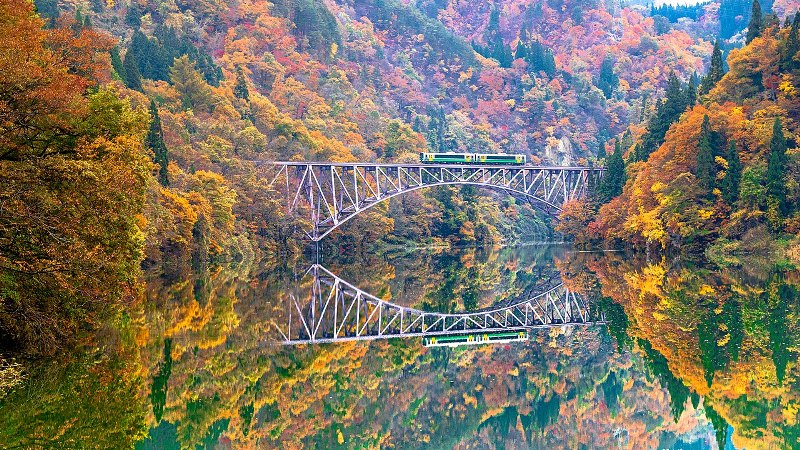
The spectacular Tadami Line, restored in 2022, ranks among Japan’s most photogenic rail trips. This beautiful route has earned a lot of positive reputations from delighted travelers who visited it over the years. The 135.2-kilometer track connects Aizu-Wakamatsu Station in Fukushima Prefecture to Koide Station in Niigata Prefecture. It showcases autumn’s vibrant colors perfectly.
The line stayed partially closed for almost 11 years due to damage from the 2011 Great East Japan Earthquake and heavy rains. October 1, 2022, marked its complete reopening. Rail enthusiasts celebrated as one of Japan’s most beautiful rural railways became fully accessible again after more than a decade.
The train winds through the Aizu region in Western Fukushima. It follows the scenic Tadami River with mountain views that burst into color during fall. The famous Daiichi Tadami River Bridge draws photographers from everywhere. This iconic spot features mirror-like waters and peaceful mountain views that look different as seasons change.
The Tadami Line Autumn Tour runs on weekends and holidays from September 13th to November 30th, 2025. This detailed one-day tour combines bus and train rides with a stop at the No. 1 Tadami River Bridge Viewpoint. Visitors can watch trains cross the valley surrounded by autumn colors. Adult tickets cost 7,670 yen while children pay 5,450 yen. The price covers lunch and guide services in Japanese.
The line connects well with major cities. From Tokyo, catch the Tōhoku Shinkansen to Kōriyama Station (80 minutes), then switch to the Ban-etsu West Line to reach Aizu-Wakamatsu Station (70 minutes). Another option starts at Tokyo’s Asakusa Station – take the Revaty Limited Express to Aizu-Tajima Station, then change to Aizu Railway for Aizu-Wakamatsu Station.
The route offers more than just fall colors. Echigo-Suhara Station sits close to Suhara ski area and Tamagawa Sake Brewery. Aizu-Wakamatsu city features historical treasures like Tsuruga Castle and the 1,300-year-old Higashiyama Onsen hot spring village.
Budget travelers should check out the JR EAST PASS (Tohoku area). It costs 30,000 yen and lets you ride unlimited JR East lines, including bullet trains, for 5 straight days.
The line stops at 36 stations. Each season brings unique views, but autumn steals the show. The wilderness outside transforms into a spectacular display of colors. This rail trip blends Japan’s cultural heritage with stunning natural beauty. It stands out as a must-do experience for anyone wanting to see Japan’s fall foliage by train.
4. Kurobe Gorge Railway, Toyama

The bright orange trolley trains of Kurobe Gorge Railway wind through Japan’s deepest V-shaped ravine. This scenic route gives travelers what many call the country’s most immersive autumn foliage experience. The narrow-gauge railway started its life in 1923 as a material transport line to the Kurobe Dam. Now it serves as one of the premier sightseeing routes through Toyama Prefecture’s spectacular Northern Japan Alps.
The railway stands out with its distinctive open-air carriages that create an unmatched connection with nature. You’ll feel the crisp mountain air without windows between you and the surroundings. The vibrant autumn colors envelop you from every angle. The route stretches 20 kilometers across more than 20 bridges and through over 40 tunnels. This makes an exciting 80-minute trip between Unazuki and Keyakidaira stations.
The stunning gorge transforms into a masterpiece during autumn. Red, amber, and gold foliage paint the dramatic cliff faces. The colors usually peak between mid-October and mid-November. The railway highlights October 20th to November 10th as the best viewing dates. Nature keeps its own schedule though. Some years see the colors arrive a week late. They grow more intense as you climb from the gorge entrance to higher elevations.
The right side seats give the best views on your way into the gorge. Most carriages come with open-sided designs and four-person bench seats. Some trains have enclosed cars with comfier seating for an extra 600 yen. The panoramic scenery stays breathtaking throughout the trip, whatever seat you choose.
The railway runs from late April through November. Autumn serves as the perfect finale to its yearly schedule. Getting there is easy. Take the Toyama Chiho Railway from Shin-Kurobe Station to Unazuki Onsen Station. A quick three-minute walk brings you to Kurobe Gorge Railway’s Unazuki Station.
5. Eizan Electric Railway, Kyoto
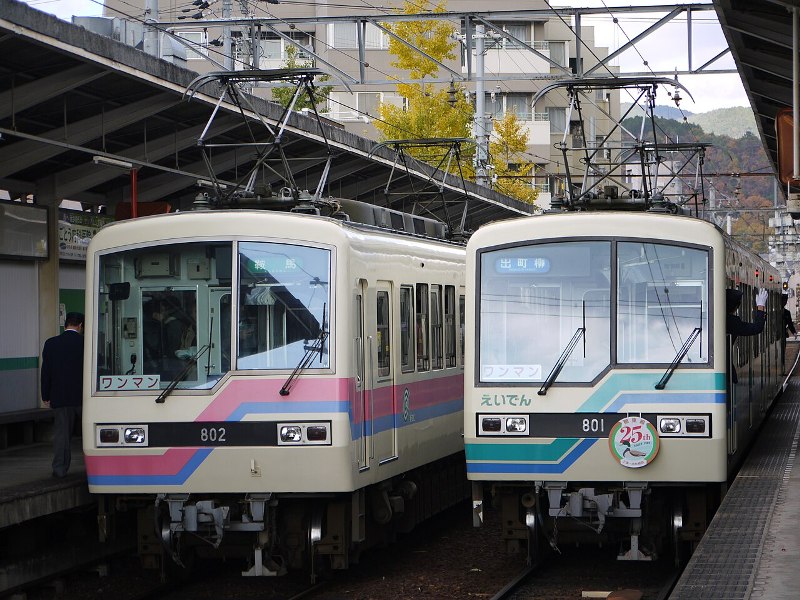
Kyoto’s charming Eizan Railway features the magical “Momiji Tunnel,” where maple trees form a natural archway of autumn colors above the tracks. This railway has become a photographer’s dream place. The exceptional trip stands out not just for the destination but for its path through vibrant autumn leaves.
The Eizan Railway runs two separate lines in northern Kyoto’s Rakuhoku area. Both lines start at Demachiyanagi Station near Kyoto Imperial Palace. Trains head north to Takaragaike Station where the route splits. One line goes east to Yase-Hieizanguchi Station while the other heads west to Kibuneguchi and Kurama stations.
The western Kurama Line shows off nature’s best display in autumn. The famous Momiji Tunnel lies between Ichihara and Ninose stations. This 250-meter stretch has about 280 Japanese maple trees around it. The railway adds a special touch to this natural wonder. Train conductors slow down and turn off all interior lights as they approach the tunnel. Passengers can then see the lit-up maple leaves without any distractions, which creates a magical experience.
Special scenic trains help visitors get the best views. The “KIRARA” train on the Kurama Line has large windows that offer panoramic views year-round. The “HIEI” train on the Yase-Hieizanguchi route provides similar viewing features.
The trip reveals cultural gems beyond the maple tunnel. Ancient spiritual sites line the route. Kurama Temple is known for its powerful energy spots, and Kifune Shrine honors the deity of water and matchmaking. The whole trip from Demachiyanagi Station to Kurama takes just 30 minutes. The scenery changes from city views to rural villages that show old Kyoto’s timeless beauty.
Autumn colors usually start in early November and last through early December, depending on the weather. On top of that, the railway works with the Kibune maple lantern event during peak foliage season. The tunnel lights up after dark. Tickets are affordable at ¥420 for adults and ¥210 for children one-way from Demachiyanagi to Kurama.
New visitors should ride all the way to Kurama Station and check out Kibuneguchi on their way back. Kibuneguchi’s platform gives amazing views of lit-up maple trees. Many photographers suggest taking multiple rides both day and night. The foliage looks dramatically different as the lighting changes throughout the day.
6. Keihan Railway, Kyoto & Osaka
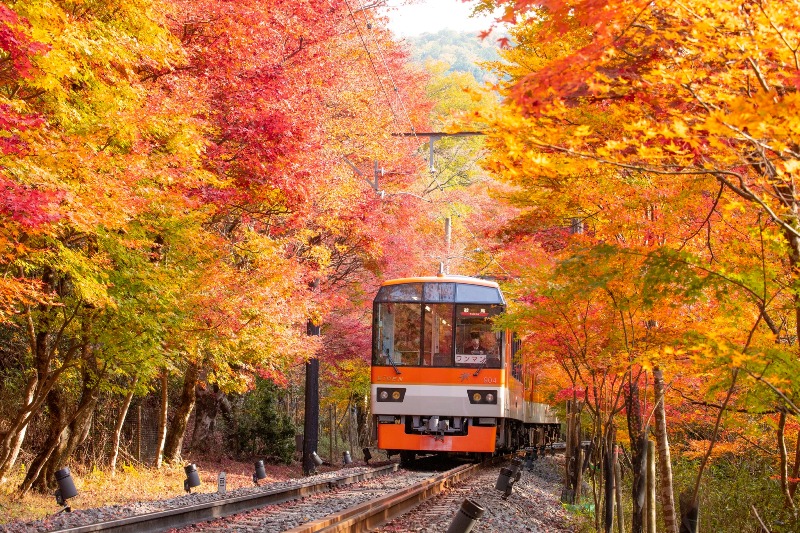
The Keihan Main Line ranks fourth among urban leaf-viewing spots. This railway connects Kyoto’s Sanjō Station with Osaka’s Yodoyabashi Station. The line has got 7,446 Instagram posts showing its autumn landscapes. Many travelers love it because they can enjoy city life and fall foliage at the same time.
Keihan Railway train features
The Keihan Main Line connects two of Japan’s most culturally rich cities. This line gives travelers an easier way to see autumn views while passing through city areas, unlike the mountain railways mentioned before. The railway system has several connected lines:
- Keihan Main Line: The primary route linking Kyoto and Osaka
- Uji Line: Perfect for accessing historical sites like Byodo-in Temple
- Katano Line: Extending the network’s reach
Modern trains on this line focus on comfort and speed. Passengers can enjoy some of Kansai’s most beautiful autumn spots from their windows. The railway’s location makes it easy to reach many fall foliage spots, from Fushimi’s vermilion gates to eastern Kyoto’s historic temples.
Keihan Railway autumn foliage experience
The Keihan line stands out because you can count on it for autumn viewing. Clear skies appear almost half the autumn season (46%) and rain falls rarely (12.7%). This means you’ll likely get great views during peak foliage season.
Orange and brown colors from the landscape shine into the train cars as they move between stations. This creates an ever-changing autumn scene. City views add something special – traditional areas and temple gardens burst with fall colors next to modern buildings.
Keihan Railway pricing and access
Keihan offers several budget-friendly sightseeing passes for leaf viewers:
KYOTO-OSAKA SIGHTSEEING PASS
- One-day: 1,650 yen / 24-hour: 1,850 yen (digital only)
- Valid: October 1, 2025 – March 31, 2026 (usable until April 30, 2026)
- Coverage: Unlimited travel on Keihan Main Line, Uji Line, Katano Line
KYOTO SIGHTSEEING PASS
- One-day: 1,100 yen / 24-hour: 1,300 yen (digital only)
- Same validity period as above
- Coverage: Keihan Main Line, Uji Line
These passes come with coupon books that give you discounts at shrines, temples, and spots along the routes. You can buy digital tickets up to three months early through their website and scan them at QR-code gates. Physical tickets are sold at specific spots throughout Kyoto and Osaka.
7. Watarase Keikoku Railway, Gunma & Tochigi
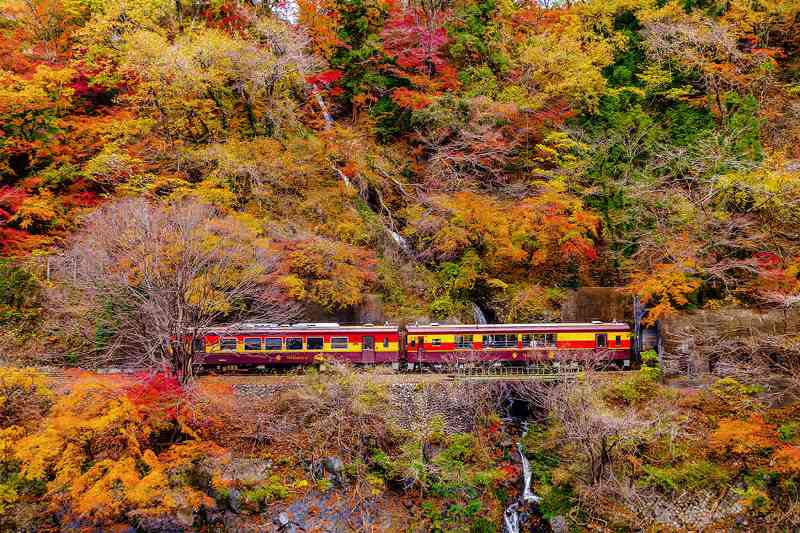
The 44-kilometer Watarase Keikoku Railway started as a copper transport line from mines. Today, it ranks among Japan’s most beautiful rural train rides. This scenic route connects Kiryu in Gunma Prefecture to Mato in Tochigi Prefecture and follows the beautiful Watarase River. The landscape looks stunning during autumn.
These trains have half open-air and half enclosed carriages. Passengers can choose between an immersive experience or protected viewing. Regular trains can’t match these special services. They give visitors a “4D experience” as they feel the crisp autumn air while watching colorful landscapes pass by.
Watarase Keikoku Railway route and highlights
The railway winds through the lush Watarase Valley and treats passengers to beautiful riverside views during the 80-minute ride. The track’s elevation changes by about 550 meters between its endpoints. This creates a unique view as autumn colors develop at different heights. Godo and Sori stations are the most interesting stops along the way. Godo Station houses a unique restaurant called Seiryū inside two vintage Tobu Railway train cars. The restaurant serves local specialties like Yamato pork and Gunma Maitake mushrooms. Passengers can even pick up pre-ordered bento boxes during brief stops.
Watarase Keikoku Railway autumn foliage experience
The ride becomes magical in autumn when the mountains burst into orange, yellow, and red colors on both sides. The colors first appear near Ashio Station in late October. They spread gradually across different heights over about a month. The railway adds extra trains during peak viewing season to let more people see this natural spectacle. The Kusaki tunnel between Godo and Sori stations makes the trip special with its 12,000 LED lights that create a 10-minute light show.
Watarase Keikoku Railway pricing and access
The Watarase Keikoku One Day Free Pass costs ¥1,880 for adults and ¥940 for children. It’s great value if you want to explore the entire line. A one-way ticket from Kiryu to Mato costs ¥1,130. The trolley trains need an extra reservation ticket that costs ¥520 one-way. The JR Ryomo Line connects to the railway at Kiryu Station. Visitors from Tokyo can take the Tobu Limited Express “Ryomo” from Asakusa Station. The trip takes about 1 hour and 40 minutes.
